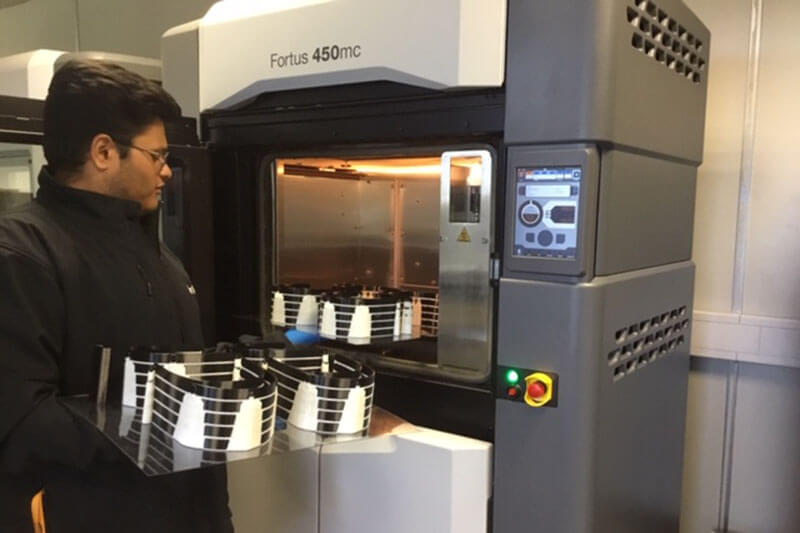It’s no secret that 3D printer technology has rapidly evolved and improved over the last decade but in unprecedented times, the major advances have allowed 3D printers to play a pivotal role in the battle against Coronavirus.
As 3D printing technology has provided businesses and organisations with a method of producing a wide range of PPE and life-saving equipment, volunteers from all over the world have started designing, sharing and printing designs that are saving lives. The accessible and straightforward production method, means that 3D printing is on the rise to fill in shortages for frontline workers. Manufacturing companies, schools and even hobbyists are using their 3D printers in order to bridge the gap in PPE equipment shortages in order to help protect front line workers.
In Spain, recently medically-approved 3D printed ventilators have gone into production, with an original design that can be replicated by anyone in the world with access to a 3D printer. Home enthusiasts in America are also printing vital components to help supply manufacturing chains during these unprecedented global shortages. In addition to this, university teams in the UK are racing to develop PPE masks and ventilator valves to keep the NHS well stocked throughout the pandemic.
3D Printing Respirators And Components
Thanks to the adaptability and rapid manufacturing changes that 3D printers can accommodate using different materials, design teams across the globe have been able to create and produce many different components needed in medical respirators. For example, a team in Spain have managed to create a ventilator made completely of 3D printed parts.
Similarly, an Italian hospital has started using 3D printed oxygen valves as their breathing machines had recently run out of respirator valves. Cristian Fracassi, CEO of Isinnova, stepped in to mass-produce the valve using 3D printing and saved countless lives of Coronavirus victims in the Brescia hospital.
As COVID-19 has forced a lot of manufacturing lines and factories to scale back production or shut all-together, having a 3D printer that can be operated by one individual has allowed vital parts to be created, whilst still allowing for self-isolation and social distancing guidelines to be adhered to. This has provided medical facilities across the world with a lifeline in these trying and uncertain times.
3D Printed PPE
The global shortage of PPE has been dominating the news headlines since the pandemic began. Following requests for help by governments across the world, manufacturing teams have come up with unique and incredible 3D printed equipment that is no doubt, saving lives.
Copper 3D has created a completely 3D printed face mask design, the file for which can be downloaded and printed by anyone with a 3D printer. Although not medically proven, this design could lead the way for mass production of masks post-pandemic to ensure medical facilities are never again short of PPE. This additional medical equipment is key in helping to cut down future transmissions of the virus and prevent a second outbreak.
Meanwhile, here in the UK, it is a well-known fact that the biggest issue facing the NHS is the lack of personal protective equipment, with many key workers treating infected patients unprotected. University teams have been rapidly developing new designs of respiratory masks, ventilator parts and more in order to aid the NHS. Across the country, 3D printers have been churning out face masks at an incredible rate, for use by key workers not only on the frontline but also cleaners, cooks and volunteers.
A collaboration between enthusiasts and, with the help of Laser Lines Ltd, 3D printing companies including Brunel University London, has resulted in Guy’s and St Thomas’ NHS Foundation Trust receiving its first delivery of face shields created in a specially developed ‘3D printing farm’, With over 200 printers working day and night, this amazing collaboration is producing 1,500 face shields every day.
AMRC at the University of Sheffield is also printing thousands of protective face visors for local hospital workers, with the university shop floor quickly changed to a production line following the outbreak.
Stratasys has mobilised its global force of 3D printers and partners to reach a goal of 40,000 face shields being printed every week. The files can be downloaded by anybody with the capacity to create 3D printed parts. The sharing of these files has proven essential in allowing large amounts of PPE to be produced. Even the most simple 3D printed components, capable of being produced by even the simplest 3D printer, are proving invaluable during this time. For instance, the hands-free door handle opener from Materialise has a super simple design however, it helps to prevent the further spread of infection and brings us a step closer to victory in the fight against COVID-19.

